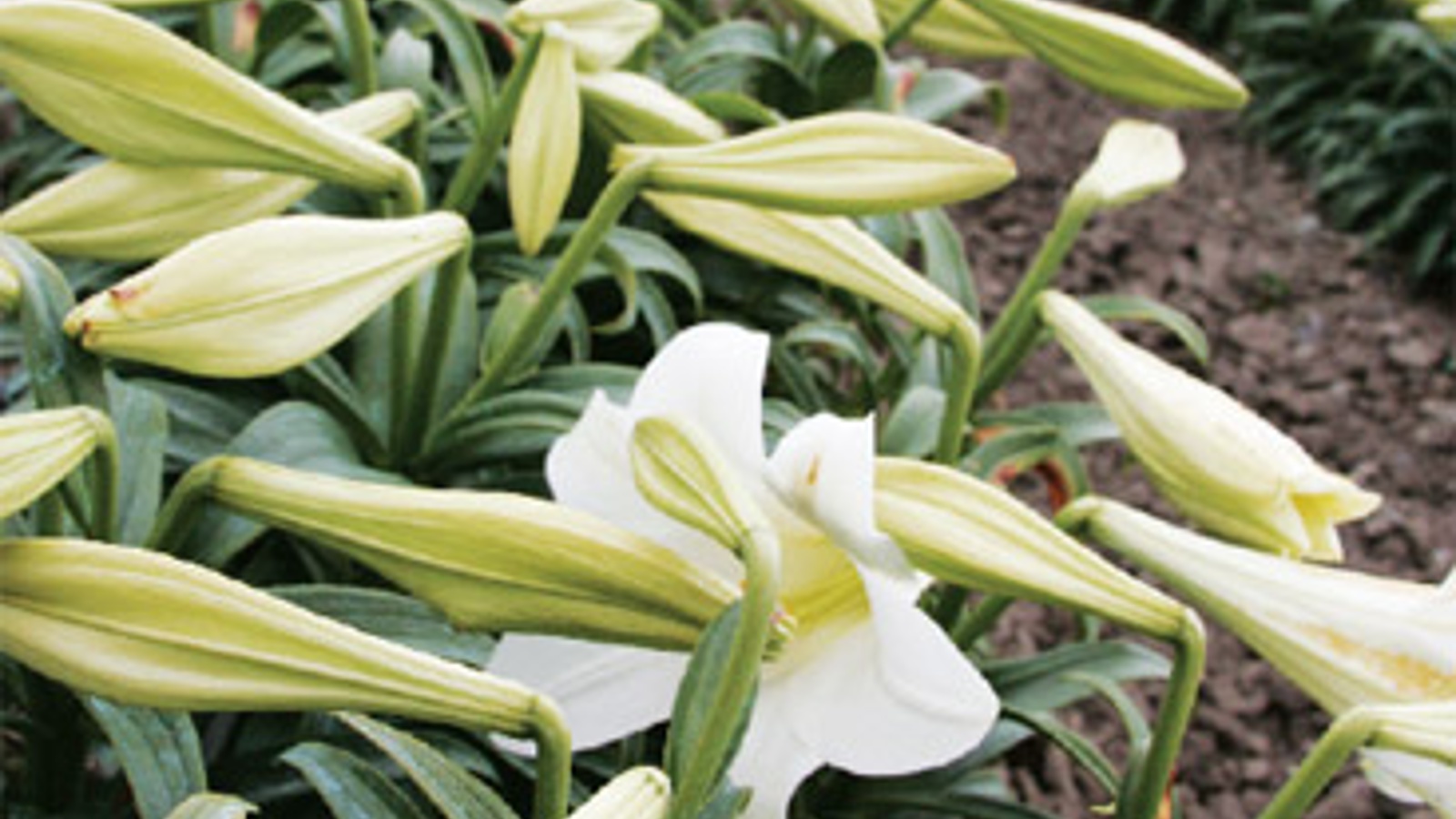The Easter lily

From well-tended bulbs to springtime splendor
If it were up to the Easter lily, the Christian holiday for which it was named would be celebrated in the middle of summer, when the lily's majestic, trumpet-shaped white flowers are in full bloom.
Easter, of course, comes much earlier than that—a few months too early for actual Easter lily season if it weren't for the hard work of growers who help bring the flowers to life in time for the celebration.
In many ways, the Easter lily is very much like the religious holiday it represents. Every year, it is resurrected in the spring after a long and arduous process that begins on a 12-mile stretch of land along the coast of the California-Oregon border.
This region, which spans from Del Norte County in California to Curry County in Oregon, is known as the Easter lily capital of the world. It is where virtually all of North America's Easter lilies are grown.
Just seven farms—five in Northern California and two in Southern Oregon—supply the more than 12 million Easter lily bulbs that are shipped across the United States and Canada every year.
One of those farms is Crockett United Lily Growers in Smith River, an unincorporated town about 13 miles north of Crescent City in Del Norte County. Every June and July the fields are inundated with rows and rows of blooming lilies and workers moving down those rows to pick them.

The Crocketts—from left, Don, Davy, Joyce and Linda—run Crockett United Lily Growers in Del Norte County, one of only seven farms in California and Oregon that grow Easter lily bulbs for the entire North American market.
Linda Crockett, who runs the Easter lily farm with her brother, Don, said her workers aren't harvesting those flowers. They're getting rid of them. That's because as a bulb producer, her main concern is growing a good-quality bulb that the greenhouse can later make bloom in time for Easter.
"We don't sell that bloom," she said. "The only thing I care about is the bulb."
Removing the lily blooms or buds in the field is important because it helps the bulb save energy and grow into a bigger bulb, said Crockett, who is also executive director of the Del Norte County Farm Bureau.
"It takes us three years to grow a large enough bulb for greenhouse floral production," she said. "It's a huge process, and it's extremely labor intensive."
Unlike other farmers who plant their crop, let it grow, then harvest it later, the Crocketts plant, harvest and ship their crop all within a span of three months—from mid-August to mid-November. The fieldwork is all done by hand.
Because it takes at least three years to grow the bulb to commercial size, the bulbs are dug up every year and sorted according to size. The mature bulbs are packed and shipped to the greenhouse. The younger bulbs are replanted back in the field.
At the same time, some of the mature bulbs are used to make new bulbs. Workers take apart the bulb, just like peeling back an onion, and plant the scales, which will grow into little bulblets the following year.
In order to force the Easter lily to bloom on Easter, growers must give the bulb at least 40 days of "fake winter" by refrigeration, then let it grow at a much higher temperature in the greenhouse. That means Easter lily farmers must properly schedule their harvest and shipping to allow the greenhouses enough time to trick the bulbs into flowering. From there, the plants go to stores and florists throughout North America.
"The Easter lily needs to be blooming for Easter because the day after it is worth nothing. Therefore, timing is crucial," said Dick denBreejen, president of Ednie Flower Bulb Inc., a distributor in New Jersey that supplies bulbs to greenhouses.
Because Easter does not fall on the same day every year and can vary by as much as five weeks, Easter lilies have to perform in a predictable manner for growers in the field and the greenhouse, said Lee Riddle, a researcher at the Easter Lily Research Foundation in Brookings, Ore.
"There's a whole science on making them bloom on that variable day," he said. "That's one of the reasons we grow so well here. Our climate is so consistent from year to year that the bulbs get used to this sameness, and we can program them to bloom for this variable Easter date a lot easier."
Although Del Norte County dominates Easter lily production today, netting nearly $7 million in farm income in 2007, the flowers originally grew wild in the southern islands of Japan. The country also dominated the lily bulb market until the 1940s, Riddle said.
At that time, the United States was buying nearly 40 million bulbs a year from Japan. After the start of World War II, all trade with Japan stopped and Easter lilies were no longer available for import.
"We had a very small industry of our own, mostly backyard growers," said Riddle. "When we ceased trade with Japan, that made bulbs worth a bunch of money because you couldn't get them anymore."
To cash in on the "white gold," many farmers decided to go into business. Soon, there were more than 1,200 lily growers up and down the Pacific Coast—from Vancouver, Canada, to Long Beach.
The majority of those businesses did not survive, however, because of the demanding nature of the crop, Riddle said. Many were unable to grow a consistent quality bulb because they were not in a region suitable for growing Easter lilies. Labor shortages, pest issues and other market challenges also contributed to the dwindling number of Easter lily growers.
The Crockett family got into the Easter lily business in the mid-1980s after purchasing land from a neighbor who was growing the bulbs. The Crocketts were beef and dairy farmers and didn't know much about growing Easter lilies.
"My father really wanted the property, but he did not really want the Easter lilies because it was a crop and it's risky and subject to Mother Nature," said Linda Crockett.
She noted that her parents, Davy and Joyce Crockett, were both in their 60s at the time and had already paid off all their own property, so taking on the lily farm "was a big step for them."
Joyce Crockett said she and her husband bought the farm mainly because it was contiguous to their property but also to give their daughter and son, Don, the opportunity to run their own business. The siblings have since been managing every aspect of the lily operation.
"I think you always have to expand," said Joyce Crockett. "We're good farmers. We were capable of expanding it and making it better, so we did."
When they started out, the farm was struggling and they did not have any Easter lily sales, Linda Crockett said. Not only did they have to learn how to grow the bulbs but they also had to prove to buyers that they are good growers. Crockett traveled throughout the state to promote their lilies and slowly build their reputation.
"We put everything we had into this business and drew very, very small salaries—in fact, hardly anything," she said. "Now our business has grown 100 percent since then."
They are also one of the last remaining Easter lily growers left in the region. In addition, the bulb business has allowed the family to have the largest beef operation in the county. That's because grazing cattle put nutrients back in the soil when the land is not being used to produce bulbs.
Growing Easter lilies and raising livestock keep the Crocketts busy year-round.
"We're constantly moving," said Linda Crockett. "It's a healthy life. It really is a good life. And I really enjoy it."
Easter lily how-to's
Easter falls on April 12 in 2009. Here are some tips for buying and caring for an Easter lily:
- Look for plants in various stages of bloom, preferably with unopened buds to partially open flowers. The higher the bud count, the more days you'll have blooms.
- Choose plants that are proportional in size with dark, rich green leaves all the way down to the soil line.
- Remove the yellow anthers before the pollen starts to shed. This will help the flowers last longer.
- Keep the plant moderately moist and well drained at moderately cool temperatures, about 60 to 65 degrees. Avoid drafts and excess heat, such as from fireplaces.
- Avoid waterlogged or wilted plants.
- Give the plant bright, indirect natural sunlight.
- Water when the soil surface feels dry. Avoid overwatering.
- After Easter, the Easter lily bulb can be replanted outdoors in the garden. Continue to water the plant as needed. Plant the bulb 3 inches below ground level in a well-drained garden bed in a sunny location. Add 3 more inches of topsoil over the bulb. Water immediately and thoroughly.
For more tips: www.easterlily.org.
Ching Lee is a reporter for the California Farm Bureau Federation. She can be reached at 800-698-FARM or clee@cfbf.com.

